Weaving Meaning: The Semantic Web
Eric Miller, W3C Semantic Web Activity Lead
American Association of Law Libraries
2002-07-23
Orlando, FL USA
Slides available at:
http://www.w3.org/Talks/0723-aall-em/

Overview
- W3C
-
Overview of the W3C Semantic Web Activity
- Background, Structure, Goals and Principles
-
Enabling Standards and Technologies
- RDF, RDF Schema, Web Ontologies, Future work
-
Relationships between Semantic Web and Law Libraries
- Observations
- Current implementations
-
Future Directions
- Lessons Learned
- Where we're going from here
- Open Discussion
W3C
"Leading the Web to its Full Potential"
Membership organization
500+ members, 60+ staff
Hosted at MIT, INRIA and KEIO
HTML, XHTML, XML, RDF, Semantic Web, Web Services, XSL, CSS,
WAI, etc.
Enabling technologies for the web of today and tomorrow
The Semantic Web: What is it?
- Many things to many people...
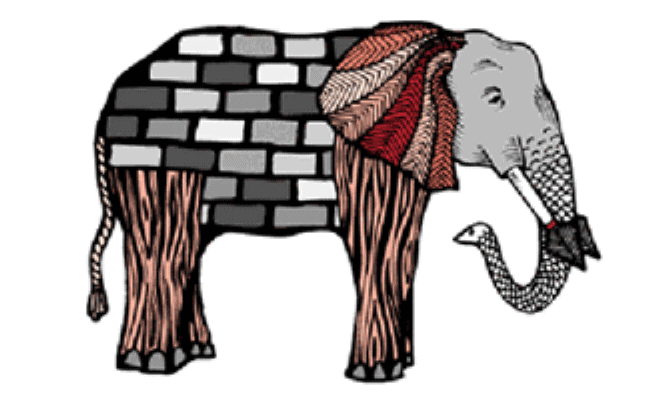
The Semantic Web
- An interesting bed-time story... still!
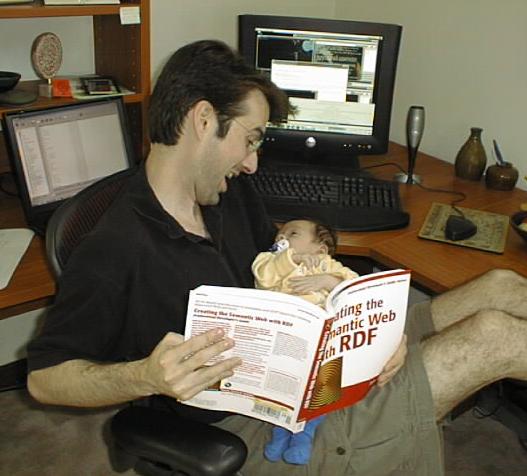
Current Web
- Resources:
- identified by URI's
- untyped
- Links:
- href, src, ...
- limited, non-descriptive
- User:
- Exciting world - semantics of the resource,
however, gleaned from content
- Machine:
- Very little information available - significance
of the links only evident from the context around the
anchor.
|
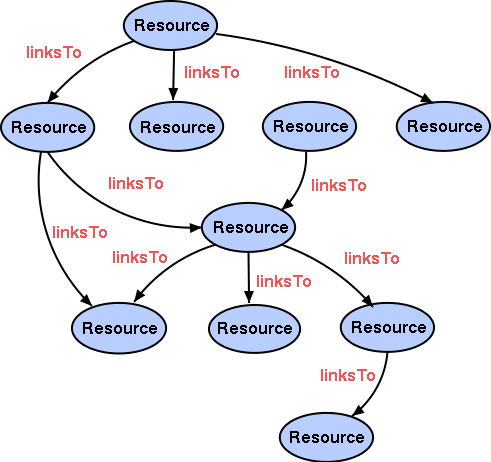
|
Semantic Web - Simple Extension to the Current
Web
- Resources:
- Globally Identified by URI's
- or Locally scoped (Blank)
- Extensible, Relational
- Links:
- Identified by URI's
- Extensible, Relational
- User:
- Even more exciting world, richer user
experience
- Machine:
- More processable information is available
- New applications to help work, learn
and exchange knowledge effectively
|
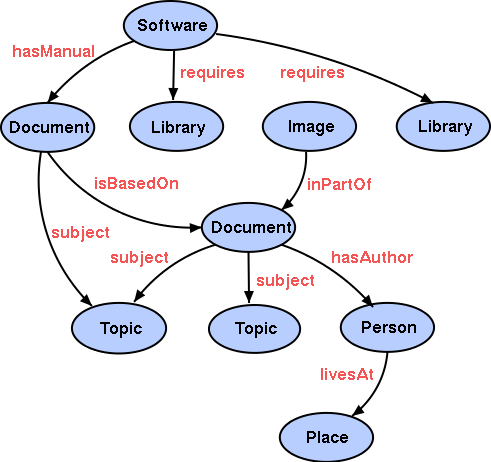
|
What is the Semantic Web?
The Semantic Web is an extension of the current web, in
which information is given well defined meaning, better
enabling computers and people to work in cooperation.
Information that has well defined meaning is in a form that
machines can understand, rather than simply display.
Machine understandable documents does not imply some
magical artificial intelligence allowing machines to comprehend
human speech, rather it relies solely on the machine's ability
to solve well defined problems by performing well
defined operations on well defined data.
or, another way to think about it...
The Semantic Web is a mesh of information linked up in such
a way as to be easily processable by machines, on a global
scale.
You can think of it as being an efficient way of
representing data on the World Wide Web, or as a globally
linked database.
W3C Semantic Goals
- Realizing the full potential of the Web
- Making it cost-effective for people to effectively record
their knowledge.
-
Focus on machine consumption.
- "The Semantic Web is an extension of the
current web in which information is given well-defined
meaning, better enabling computers and people to work in
cooperation." -- Tim Berners-Lee, James Hendler,
Ora Lassila, The Semantic Web
- "The bane of my existence is doing things that
I know the computer could do for me." -- Dan
Connolly, The XML Revolution
- Ultimate goal - the design of enabling technologies to
support machine facilitated global knowledge exchange
W3C Semantic Web Activity - Structure
The Semantic Web Activity
- Semantic Web is part of the W3C Technology and Society
Domain
-
Managing the Development Enabling Standards and
Technologies
-
Supporting Advanced
Development
- Explore pre-competitive, prototype development for
supporting the Semantic Web
-
Investing in
Education and Outreach
- Clarification of design, goals, implementation
guidelines
- Position papers, Articles, Presentations, Tutorials,
Tools
W3C Semantic Web Activity - Approach to Deployment
- Establish guiding architectural principles
- Facilitate the design of enabling standards and
technologies
- Focus on short term deployment
- Eye toward longer term research issues
- Understand policy implications
- Foster an environment for effective cooperation and
collaboration
- A lot of hard work
- And a bit of luck
Semantic Web Principles
Everything Identifiable is on the Semantic Web
- All resources have identity
- People, places, and things in the physical world will
have online representations identified by Uniform Resource
Identifiers.
- URI's facilitate effective integration, active
participation and be contextualized in the Semantic Web.
Semantic Web Principles
Partial Information
-
The Web is unbounded.
- The original design of the Web differed from
traditional hypertext systems in sacrificing link
integrity for scalability.
-
The Semantic Web it unbounded.
- Anyone can say anything about anything.
- There will always be more to discover.
Semantic Web Principles
Web of Trust
- All statements found on the Web occur in some
context.
- Applications need this context in order to evaluate the
trustworthiness of the statements.
- The machinery of the Semantic Web does not assert that
all statements found on the Web are "true".
- Truth - or more pragmatically, trustworthiness - is
evaluated by each application that processes the information
found on the Web.
Semantic Web Principles
Evolution
- The Semantic Web must allow the independent work of
diverse communities to be combined effectively.
- Support the ability to add new information without
insisting that the old be modified.
- Provide communities the ability to resolve ambiguities
and clarify inconsistencies.
- Semantic Web must be based on descriptive conventions
that can expand as human understanding expands.
Semantic Web Principles
Minimalist Design
- Make the simple things simple, and the complex things
possible.
- Standardize nor more than is necessary.
- More than the sum of the parts
Semantic Web
Building on proven ideas
- Combines RDF, XML, Xlink, hypertext and metadata
approaches to linked data
- Enable simple applications now that plan for future
complexity (eg. Dublin Core, RSS, PRISM, MusicBrainz)
- Focussed on general principles of Web automation and data
aggregation
Architectural aims
- Define a convention for applications that exchange
metadata on the Web
- XML used for "serialization syntax"
- Enable vocabulary semantics to be defined by communities
of expertise, not W3C
- Provide for the fine-grained mixing of diverse
metadata
A solution: RDF
RDF - A Semantic Web Enabling Technology
-
"Resource Description Framework"
- W3C
Recommendation
- Language for making statements about things
- Can be used for any kind of statements
- Has XML syntax: "RDF/XML"
- Uses (simplified, explicit) entity-relational data model
RDF Schema
- RDF Vocabulary that allows classes (e.g. Case,
Organization) and properties (e.g. plaintiff, defendant) to
be defined in a reusable manner
- Subclass, sub-property, domain, range simple constraints
Web Ontology
-
Builds on RDF Schema and extends these constructs to allow more
complex relationships between entities (e.g.):
- limit the properties of classes with respect to
number and type
- means to infer that items with various properties are
members of a particular class
- a well-defined model for property inheritance
Adapting the Relational Model for the Web
- Use URIs as keys
-
Use subject-verb-object triples as a way of expressing of tables
<subject> <verb> <object>
<subject> <property> <value>
- (Simplified relational model)
Example Triple
(Not RDF/XML syntax):
http://example.org/case123 |
(Subject) |
http://example.org/legal/vocab#plaintiff |
(Verb/Property) |
http://example.org/co1 |
(Object/Value) |
Meaning: "Case case123 has plaintiff Company co1"

Joining Triples to Create a Graph
- Triples can be viewed as links in a graph
- Equivalent of "joining" in relational database
-
Joining is automatic in RDF, because:
- Nodes are URIs (unambiguous)
Joining Data from Multiple Sources
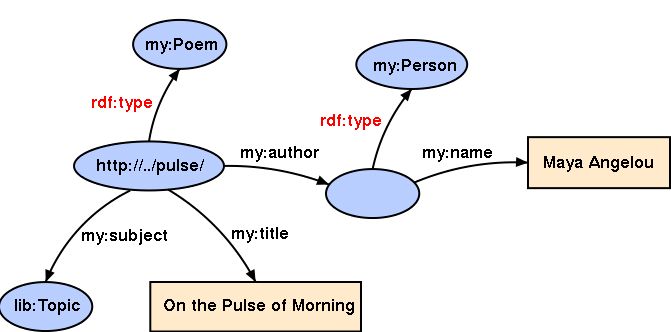
Joining Data from Multiple Sources

Joining Data from Multiple Sources
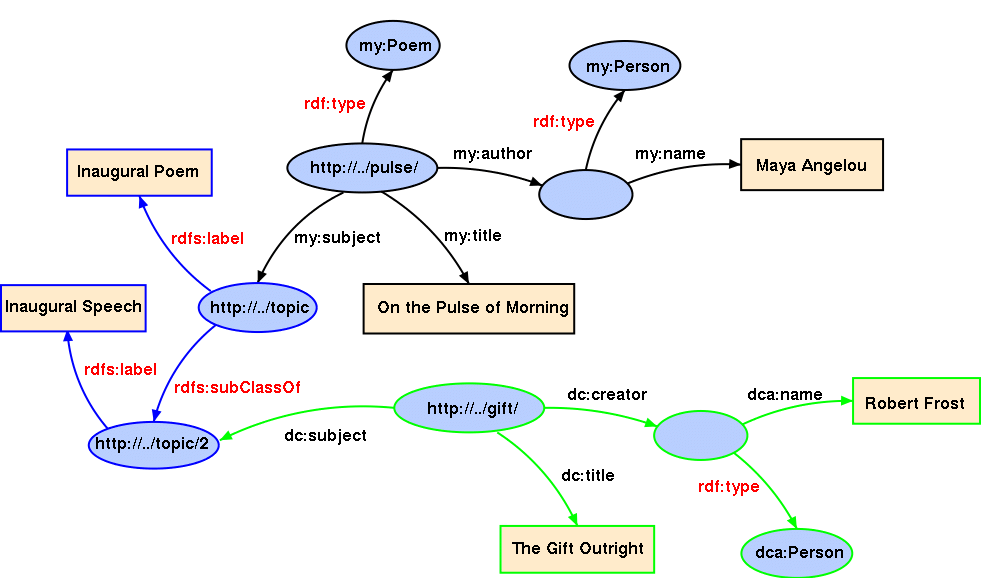
Semantic Web
The Semantic Web is a mesh of information linked up in such
a way as to be easily processable by machines, on a global
scale.
Contextualize resources.
Globally linked database.
Designed of enabling technologies to make the simple things
simple, and the complex things possible.
More than the sum of the parts
Law Libraries and the Semantic Web
- Conference theme: "creating connections"
As managers of information, it seems that we are expected
to know everything and be connected to everyone. We are
expected to CREATE connections where they may not have existed
previously
- Personal theme
- When these connections are created, there
are done so in a way that can be shared effectively in a global
environment.
- More specifically, identification of technical and social
areas of overlap between Semantic Web and Law Libraries.
- Help facilitate libraries as key foundations for supporting
the Semantic Web.
- learn
Some Observations
Effective dissemination of information
"more information than less, sooner rather than later"
Candidate for RSS,
RDF/XML information syndication vocabulary
Unique Identity
URI's of West-Digits
URI's for Cases, Plaintiffs, Defendants, etc.
National Reporter System
Classic case of Semantic Web Annotations
Knowledge Sharing
Libraries to record answers to patrons questions, and build
federated knowledge base
Vocabularies
Record the semantics used in your applications
Add Value
In a world where 'anyone can say anything about anything' who
makes these assertions is vital for establishing trust.
Current Implementations - small but important steps
Creative Commons
Creative Commons is a non-profit organization founded on the
notion that some people would prefer to share their creative works
(and the power to copy, modify, and distribute their works)
instead of exercising all of the restrictions of copyright
law.
http://creativecommons.org/
RDF Legal Dictionaries
Open source development of a multi-lingual and
multi-jurisdictional RDF Dictionary for the legal world.
http://rdf.lexml.de/
Conclusions
- Supporting simple to complex systems using common infrastructure
- Optimal data reuse in networked environment
- Potential for strong synergy
- Perhaps not surprising since semantic web technology was greatly
influneced by Digital Library communities
- More formal understanding of these relationships however
are still required
- Great opportunity for the Law Library communities to
help shape the Semantic Web
More information
Special Thanks
to Bruce Johnson, Associate Dean for Infomation Science and
Proffessor of Law at The Ohio State University





